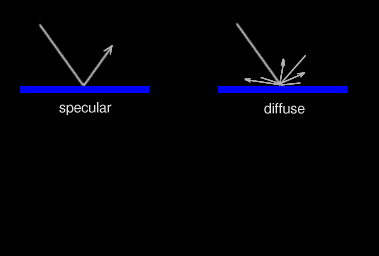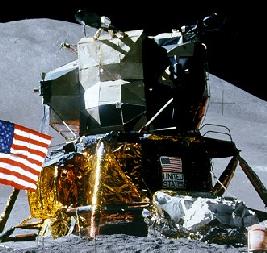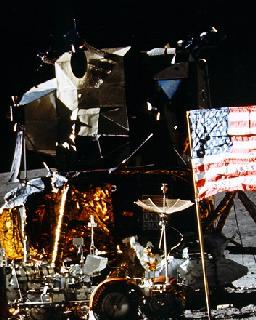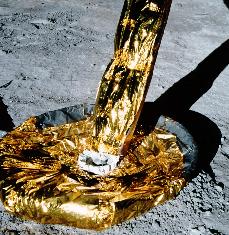pride run amok







|
|
|
There is evidence that the sun azimuth angle is different in this photograph. Our tank housing is lit quite differently. More of the panels are dark. And we can see a distinct shadow from the right rear RCS quad falling across the tank; that shadow is missing in the top photo because it's falling somewhere else.
We conclude that the visible side of the lunar module is turned more away from the sun in Fig. 2 than in Fig. 1. This is important because it determines how much light falls on a key piece of Apollo hardware -- the MESA.
In Fig. 1 we can see the MESA deployed. With the lander turned relative to the sun as we suppose, the MESA is subjected to direct sunlight. The white cover blankets are in full sun. They act like photographic reflectors to cast indirect light on the decals.
In Fig. 2 the lander is turned a different direction. And although the MESA is difficult to see, the white blankets visible below the dishlike LRV S-band antenna are not as fully lit as those in the above photo. Less indirect light, and therefore less visibility. The MESA blankets are made from Beta cloth, the same highly reflective material that covers the space suits.
And consider the ubiquitous indirect lighting from the lunar surface. The more a lunar module feature points down-sun, the more likely it will be in the lunar module's shadow and not benefit as much from indirect lighting from the lunar surface. In Fig. 1 the decal directly faces portions of the lunar surface likely to cast indirect light on it. Not quite as true for Fig. 2.
The decal placement changed on the upgraded lunar modules used for Apollo 15, 16, and 17. Earlier missions placed the U.S. flag on the LMP's side and "United States" on the commander's side. In later missions both decals appeared on the MESA side. Obviously the MESA can't be the primary light source for decals on the opposite side of the LM. Indirect light from the lunar surface accounts for that.
THE OTHER HALF OF THE
PROBLEM
We've determined that the apparent brightness of the decal roughly correlates to the degree of indirect light from the MESA blankets, and potentially from the lunar surface. This is considerably more parsimonious than postulating the existence of supplementary lighting. Since David Percy categorically rejects the lunar surface as a source of indirect light and tends to disbelieve any explanation which involves straightforward sources of indirect lighting, he is likely to reject this explanation as well. But the correlation does not go away, and it explains the apparent lighting anomaly in terms of what is visible in the photos without resorting to speculations of hidden equipment for which there is no proof.
But we've only answered the first of Percy's questions. We've determined that the source of the light is likely to be the indirect light from the MESA blankets and possibly from the lunar surface. But that doesn't explain why the decal is so brightly lit compared to its background.
To answer this question we have to look at the two broad modes of light reflection.

|
"Specular" reflection is the kind we see from shiny objects like mirrors (Latin "speculum") or polished metal or glass. Like a billiard ball bouncing from a rail, the light rays bounce off a surface at the same angle at which they struck it. When we see the blinding glare of the sun in the chrome or windows of the car in front of us, that's an example of specular reflection.
"Diffuse" reflection on the other hand is what we see from textured objects. Light striking such an object is scattered in all directions. Slightly weathered rubber is a good diffuse reflector, as is chalk.
Most surfaces are both diffuse and specular reflectors. That is, the total phenomenon of reflection from any single surface is a combination of specular and diffuse reflections in different proportions, depending on the microscopic texture of the surface.
Whether an object appears bright or dark to our eye depends on whether light reflected from the object arrives at it. And that in turn depends on whether an object is primarily a diffuse reflector or primarily a specular reflector. Since specular reflectors reflect light only in one direction, you have to be in the right place to intercept the reflected light and thus perceive the object as bright. But diffuse reflectors reflect light in all directions. As long as light is falling on it, you can be almost anywhere and still see light from a diffuse object.
The lower half of the lunar module is almost completely covered with thermal insulation made of Mylar coated with a very thin coat of aluminum. It is affixed with the Mylar side facing outward. This material -- similar to the anti-static bags in which computer components are packaged -- mimics the reflective capabilities of shiny metal but without the associated weight. By reflecting away about half of the sunlight that strikes the spacecraft the insulation keeps the spacecraft from becoming too warm.
|
Fig. 3 shows the LM footpad in full sun. Some of the golden insulation appear black. This is because the crinkled insulation forms facets, each of which points in a different direction. And each therefore reflects light only in a direction controlled by the orientation of the facet and the angle of light incidence. Another way to think about it is to treat each insulation facet as a mirror. Some facets are oriented to reflect an image of the pitch black sky (e.g., those areas near the top of the photo). Some are oriented to reflect the brightly lit lunar surface -- even from far away (e.g., the areas near the "ankle"). And some are oriented to reflect the full light directly from the sun (e.g., the hot spot near the toe).
This seems complicated, but the bottom line is that when this insulation looks "dark" it's not necessarily because there's no light falling on it (from whatever source). Many of the facets in this case are reflecting that light away from the photographer where the camera can't capture it. And so while light may be streaming onto the surface, none of it is getting to the camera. On other hand, the decal reflects a portion of the incident light in all directions and some of it will find the camera no matter where the camera is.
 I don't buy your shadow
analysis. The Apollo 16 photo looks like it was taken with darker
exposure and this might account for the differences in shadow
darkness.
I don't buy your shadow
analysis. The Apollo 16 photo looks like it was taken with darker
exposure and this might account for the differences in shadow
darkness.
Then it might also account for why one decal is lighter than the other.




